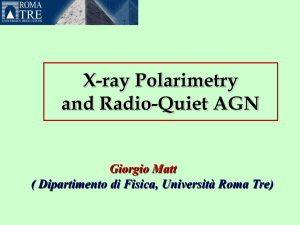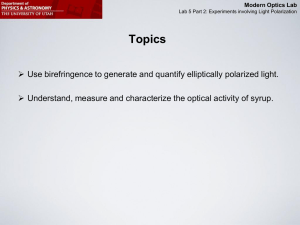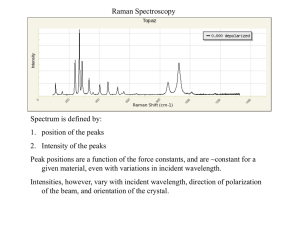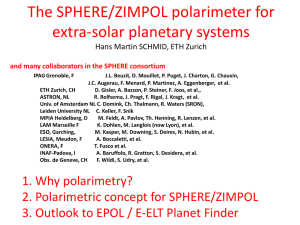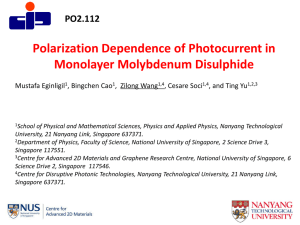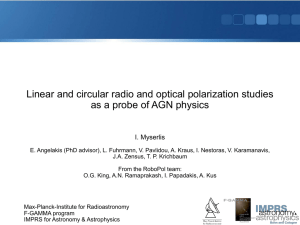X-ray Polarimetry - XMM-Newton Science Operations Centre
advertisement
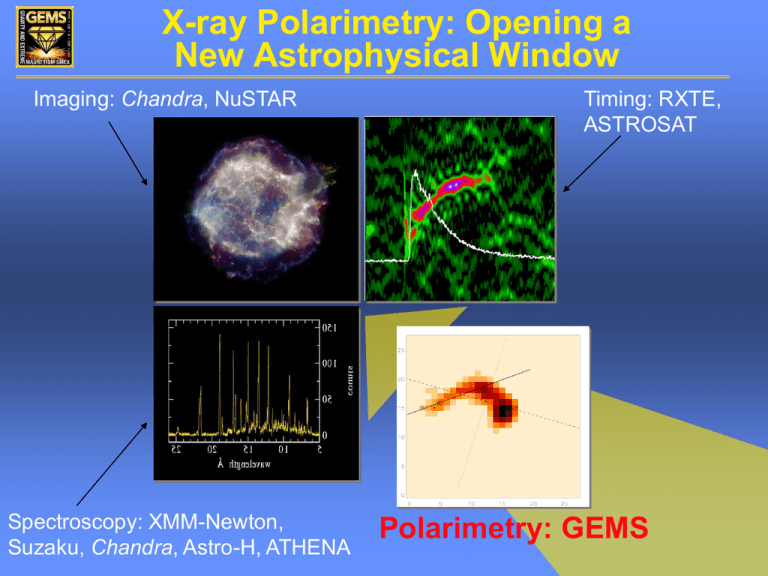
X-ray Polarimetry: Opening a New Astrophysical Window Imaging: Chandra, NuSTAR Spectroscopy: XMM-Newton, Suzaku, Chandra, Astro-H, ATHENA Timing: RXTE, ASTROSAT Polarimetry: GEMS Outline GEMS Science Objectives Why polarimetry? Source classes: black holes, neutron stars, supernova remnants GEMS Overview X-Ray Polarimeter Instrument Bragg Reflection Polarimeter - Student Experiment Mission Design Polarimeter Design and Performance Data Analysis and Science Content Conclusions Polarimetry probes physics of photon emission and propagation • Polarization measurements allow us to study: Scattering geometry Magnetic fields Strong gravity GEMS will use these processes to probe black holes, neutron stars and supernova remnants X-ray polarimetry history: detection of the Crab Nebula • To measure nebular polarization, need to look at phases when pulsar is “off” • X-rays from nebula 19.2%±1.0% polarized at 156.4°±1.4° at 2.6 keV; 19.5%±2.8% polarized at 152.6°±4.0° at 5.2 keV (Weisskopf et al. 1978) • γ-rays: Off pulse and bridge emission polarized at 122.0°±7.7° (Forot et al. 2008) • Consistent with 124°±0.1° projected pulsar rotation angle • • PF>72% (off pulse) >88% (off pulse plus bridge) Consistent with 77% polarized signal along pulsar rotation axis, maximum • IBIS measurement probably from particles in equatorial wind near the termination shock. Electrons have energy as high as 250-500 TeV, lifetime of 0.85-0.43 year, and do not travel more than 0.09 pc. • X-rays sample larger region (thus lower fraction); less order (thus different angle) X-ray polarimetry provides a new way to study black holes • X-rays are the best electromagnetic probe of conditions close to the event horizon • This allows study of the structure of the accretion flow • And of the black hole effects on space-time • Current models for spectra and timing make predictions of the polarization behavior, and we can test them • Polarization also provides a complementary way to probe black hole spin X-ray emission from soft state black holes is dominated by the disk • In an optically thick accretion disk, the atmosphere is dominated by Compton scattering Disk interior • Compton scattered radiation can be 100% polarized perpendicular to the scattering plane for a single 90o scattering • In an atmosphere there are a range of scattering angles • The polarized fraction is 0-12%, depending on inclination (Chandrasekhar 1960) • The polarization direction is parallel to the disk surface cos(i) X-ray propagation near a black hole reveals its gravity Propagation to the observer is affected by: •Special relativistic effects: Doppler shift, aberration, beaming •General relativistic effects: gravitational redshift, light-bending Schnittman (2010) Plus, the disk illuminates itself via gravitational effects This returning radiation, which scatters 90o into our line of sight, has a significant effect on polarization Image of disk, intensity as color, polarization vectors a/m=0.998 i=70o Two regimes in black hole polarization behavior (Schnittman and Krolik 2009) • At lower X-ray energies, photons are emitted far from the black hole • Relativistic effects are weak • Position angle is parallel to disk plane and is a function of inclination, as predicted by Chandrasekhar • At higher energies, relativistic effects become important • polarization direction becomes perpendicular to disk and fractional polarization increases Strength of return radiation is sensitive to spin Schnittman and Krolik (2009a) • Strength of return radiation depends on spin • Therefore, transition energy between the direct and return-dominated regimes, and strength of high energy polarization, depend on spin Black holes in the hard state: effect of a hot corona • Observed spectra in black hole ‘hard state’ are likely associated with Compton up-scattering of thermal photons by a hot (~109K) corona • This corona likely encloses some or all of the thermal disk • Details of the corona conditions (extent, temperature, location) have not been well constrained by spectra or temporal signatures • Polarization provides a means to do this… GEMS observations can constrain black hole spin • A GEMS observation of a stellar mass black hole in the thermal state can measure expected dependences on angular momentum • Short observations (30 ksec) will be capable of detecting 1% polarization in 2-4 keV and 4-8 keV bands • In the case of hard state black holes, GEMS will be able to test for the combined effects of spin and coronal geometry X-ray polarization from pulsars probes strong magnetic fields, gravity •Strong magnetic fields of neutron stars lead to significant polarization effects. (108 < B < 1015 G) •Electron scattering in strong magnetic fields is highly polarizing •This provides a way to learn about geometry of field and X-ray emitting region •Pulse phase resolved observations provide changing view of neutron star •Propagation of polarized light provides further information: strong gravity and strong field effects In a strongly magnetized plasma, scattering is affected by the field For energies below the cyclotron frequency (w<<wce=11.6B12 keV), photons divide into two propagation modes: 1) O-mode (parallel mode): E nearly in the k-B plane 2) X-mode (perpendicular mode) E nearly perpendicular to the k-B plane The two modes have very different opacities k O-mode~ k B=0 k X-mode~ k B=0 (w/wes)2 --> In a magnetized atmosphere, such as on a neutron star, the photosphere for X-mode is much deeper than for the O-mode --> X-mode is the main carrier of X-ray flux --> X-rays are strongly polarized in the direction perpendicular to the k-B plane (Lai, Vanadelsberg, Heyl 2009) Putting a polarimeter on the neutron star surface • At the neutron star surface, X-rays will be strongly polarized for all viewing angles >10o from B • Polarization direction indicates field orientation (Lai, Vanadelsberg, Heyl 2009) After the photon leaves the surface, it is subject to.. • GR light bending • Mixing with photons from elsewhere on the surface • These effects will tend to dilute the net polarization • QED effects, ‘vacuum polarization’, can effectively freeze the polarization to the field direction • This counteracts the mixing of polarizations from GR and enhances the net observed polarization observer • Polarization will be perpendicular to k- plane even when field is non-dipole (for B>1013G) Polarization signals carry information about polarization • The polarization signals can be very different even when pulse profile is similar Angle/p • Linear polarization sweep tells about the geometry (cf. “rotating vector model” in radio pulsars) flux Expected Characteristics of Net X-ray Polarization •Geometry (magnetic field, rotation axis) •Bound on field strength •Weak dependence on M/R •Manifestation of QED effects (Lai, Vanadelsberg, Heyl 2009) The GEMS X-Ray Polarimeter Instrument (XPI) • 2-10 keV range • 2 Mirrors with 4.5 m focal length (a Suzaku mirror, but 29 cm diameter versus 40 cm) • 2 Polarimeters imaging photoelectron tracks • 2 independent telescopes (mirror and polarimeter pairs) Instrument support structure Telescope optical boom (ATK) Mirror optical bench A Time Projection Chamber (TPC) is used to track photoelectrons Measures the projection of the electron track in the X-Y plane with time and space measurements X-ray E sin2cos2 distribution Micro pattern gas detector (MPGD) X-Ray Drift electrode primary e- Auger electron Photoelectron Y X Strips Drift field GEMS Mission Design • Spacecraft bus from Orbital (proven heritage of AIM & GALEX) • Low Earth Orbit at 565 km • 28.5 degree inclination • Pointing 90o ± 25o from the sun • Long pointings (1 - 60 days) • ~50 % duty cycle (considering earth occultations and South Atlantic anomaly passages with the voltage off) • All the sky passes overhead in 6 months • Mission Operations at Orbital’s multisatellite facilities • Downlink 1-8 per day (average 2-4) • Uplink once per week • ~25 sources observable to important sensitivity limits in 9 months • 9 month baseline mission duration with possible extension to enable 15 months of General Observer program The TPC Polarimeter A Bragg reflection polarimeter is a student experiment (Univ. Iowa) Multilayer reflector in optical path for one telescope reflects 0.5 keV into a position sensitive proportional counter Soft X-rays are generated farther out on black hole accretion disks The BRP would further constrain inclination and spin Photoelectron Events Event Analysis: Image Processing un-filtered filtered •Recorded pulses are convolved with signal response function. •Use measured response pulses to do optimal filtering deconvolution (Wiener filtering) to recover input. •Improves signal to noise compared to unfiltered deconvolution. Data Analysis: Reconstruction Algorithm • Start with lower charge density region (start of the track). Find pixel furthest from barycenter (mdp, square symbol) Start of track • Find peak pixel in a circle around the mdp (Auger electron). Bragg Peak Well resolved event • Compute barycenter in a circle around this point, this is the interaction point estimate (X symbol). • Compute principal axes using only the first half of the track. • Minor principal axis is angle estimate. GEMS Data Overview •Science information is contained in the sky angle distribution (left). •A significant modulation indicates polarization. •The amplitude of the modulation is proportional to the polarization fraction. •The position angle is determined by the peak of the distribution. •Distribution can be fitted to a function to derive Stokes parameters, I, Q and U. Data Products and Scientific Modeling • Observed Stokes spectra (I, Q, U), combined with detector response functions, are used to infer source parameters, address science questions • GEMS analysis requires modeling three Stokes spectra. Observed Predicted Q(C) = W(E,p) * 100 (E)*R(E,C) (GEMS specific) U(C) = Z(E,p) * 100 (E)*R(E,C) (GEMS specific) I(C) = F(E,p) *R(E,C) (previous missions) W(E,p), Z(E,p) and F(E,p) : Source models, science results! • Response functions are computed from ground & on-orbit calibration data (gemrsp) • Standard forward fitting ( 2) to constrain source model parameters then done with existing software tools, such as XSPEC • Standard data products include: Event lists, light-curves (polarized and unpolarized), Stokes spectra (I, Q, U), response functions (R(E, C) and 100(E)) GEMS sensitivity • Minimum detectable polarization 99% confidence 4.29 MDP nRsT rb 4.29 r C = modulation for 100% polarized X-rays n = number of telescopes R = counts/s per mCrab per 1 telescope s = source strength in mCrab T = observation time (neglecting background < 0.2 mCrab) Simulations with Penelope + Measured with discrete electronics Measured with APV25 GEMS observation program • The GEMS observing program: black holes, accreting binaries pulsars and neutron stars supernova remnants AGN and Blazars Plus comparable numbers of targets available for guest observers • To address questions including: Where is the energy released near black holes? What is the origin of X-ray emission from pulsars? What is the magnetic field structure in supernovae remnants? Crab nebula observation Monte Carlo assignments within a x 3 range of theoretical assignment (smaller symbols denote possible guest observer targets) The GEMS Science Team GSFC PI: Jean Swank, Deputy PI: Keith Jahoda Chair Science Working Group: Tim Kallman (Project Scientist) Polarimeter scientists: Kevin Black, Joe Hill, Wayne Baumgartner, Asami Hayato Mirror scientists: Rob Petre, Peter Serlemitsos, Yang Soong, Takashi Okajima Data: Tod Strohmayer, SOC: Craig Markwardt HEASARC archive: Lorella Angelini EPO: Sara Mitchell UI Calibration and Student Experiment: Phil Kaaret, Ryan Allured ARC Analysis techniques: Jeff Scargle, Robin Morris Multiwavelength comparisons: Jesse Dotson MIT Simulations: Herman Marshall GEMS Collaborators Mathew Baring Rice U Magnetars, SNR Alice Harding GSFC Pulsars, magnetars Henric Krawczynski Washington U, St. Louis Blazars Julian Krolik JHU Black Holes Dong Lai Cornell U Magnetars Jeff Martoff Temple U TPCs Juri Poutanen U Oulu Black Holes Steve Reynolds NCSU SNR Rita Sambruna GSFC Blazars Jeremy Schnittman GSFC Black Holes Toru Tamagawa Yuzuru Tawara Riken Nagoya MPGDs Conclusions Astrophysics needs X-ray polarization and GEMS will open the frontier • Theory provides abundant predictions of strong polarization in the 210 keV energy range from most classes of X-ray source • These need confirmation/testing! X-ray polarimetry is essentially unexplored • We can learn fundamental things: black hole spin, neutron star magnetic structure, supernova shock geometry. • GEMS can accomplish these goals using a simple, robust design • Gems will - launch in July 2014 (current schedule) - carry out the proposed program in 2014-2015 and - could carry out a general observer program 2015-2016, requires HQ approval.
